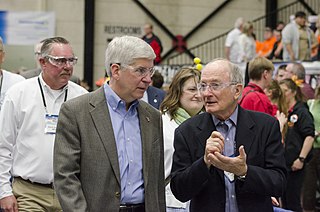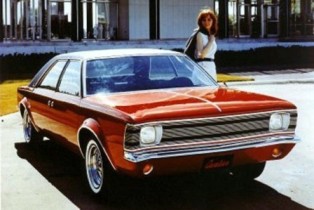


A development mule, also known as test mule or simply mule, in the automotive industry is a testbed vehicle equipped with prototype components requiring evaluation. They are often camouflaged to cover their designs.



A development mule, also known as test mule or simply mule, in the automotive industry is a testbed vehicle equipped with prototype components requiring evaluation. They are often camouflaged to cover their designs.
Mules are necessary because automakers must assess new aspects of vehicles for both strengths and weaknesses before production. Mules are drivable, sometimes pre-production vehicles often years away from realization and coming after a concept car that preceded the design of critical mechanical components. A mule or engineering development is not the same as a preproduction car because changes are made constantly as the vehicle goes through the engineering development process. [1]
Some mules are built to function as test beds for entry into new market segments such as the mid-engined test mules developed in Italy and Germany for American Motors Corporation (AMC). [2] Surviving examples of these mules are unique. [3] Manufacturers also explore different solutions such as developing an "Urban Concept" car where not only a rotary engine and front-wheel-drive were considered for a small car, but "the first mule was made by cutting down a Matador by 30 in (762 mm) in front and back." [4] Mules using modified existing cars may also be used as a development tool to simulate battery-powered vehicles by incorporating their weight, mass distribution, and suspension to evaluate ride and handling. [5]
Mules may also have advanced chassis and powertrain designs from a prospective vehicle that need testing, which can be effectively concealed in the body and interior of a similarly sized production model. [6] [7] In some cases, a completely unrelated vehicle is adapted to hide the powertrain and other mechanicals being tested. Ford used a Transit van that was modified with a mid-mounted Jaguar XJ220 engine and it had candy wrappers and tabloids on the dashboard to make it look like a regular work vehicle. [8]
If no comparable vehicle is available in-house or an external benchmark is being used mules may be based on another manufacturer's model. For example, in the 1970s the new powertrain package of first-generation Ford Fiesta was developed using mules based on the then class-leading Fiat 127, as Ford had no comparable compact model of similar size to utilize. [9]
Mules are also used to conceal styling changes and visible telltales of performance alterations in near-production vehicles, receiving varying degrees of camouflage to deceive rival makers and thwart a curious automotive press. Such alterations can span from distracting shrinkwrap designs, somewhat reminiscent of dazzle camouflage, to substituting crude cylindric shapes for taillights, non-standard wheels, or assemblages of plastic and tape to hide a vehicle's shape and design elements. [10] The wraps may also serve as part of marketing techniques to promote future car reveals. [11]
Development mules are often used very heavily during testing and scrapped. [12] Automakers also use auto racing and develop components for race cars that serve as development mules for their performance parts, such as AMC’s "Group 19" program. [13] [14] [15]
Occasionally, mule vehicles are acquired by members of the automaker's engineering team or executives overseeing the design process. [16] [17] In some cases, the test mules may be evaluated as being better than the final products. [18]

Jeep is an American automobile marque, now owned by multi-national corporation Stellantis. Jeep has been part of Chrysler since 1987, when Chrysler acquired the Jeep brand, along with remaining assets, from its previous owner American Motors Corporation (AMC).

Eagle was a brand of the Chrysler Corporation following the purchase of American Motors Corporation (AMC) in 1987 and marketed through the end of the 1998 model year. It was aimed at the enthusiast driver and promoted as more "European" than the automaker's similar models.

American Motors Corporation was an American automobile manufacturing company formed by the merger of Nash-Kelvinator Corporation and Hudson Motor Car Company on May 1, 1954. At the time, it was the largest corporate merger in U.S. history.

The AMC Javelin is an American front-engine, rear-wheel-drive, two-door hardtop automobile manufactured by American Motors Corporation (AMC) across two generations, 1968 through 1970 and 1971 through 1974 model years. The car was positioned and marketed in the pony car market segment.

The AMC AMX is a two-seat GT-style muscle car produced by American Motors Corporation from 1968 through 1970. As one of just two American-built two-seaters, the AMX was in direct competition with the one-inch (2.5 cm) longer wheelbase Chevrolet Corvette, for substantially less money. It was based on the new-for-1968 Javelin, but with a shorter wheelbase and deletion of the rear seat. In addition, the AMX's rear quarter windows remained fixed, making it a coupe, while the Javelin was a true two-door hardtop.

The Eagle Premier is a full-size executive car that was developed by American Motors Corporation (AMC) during the 1980s through its partnership with Renault. This model was manufactured in the then-brand-new Brampton Assembly in Canada. Chrysler Corporation bought the rights to the Premier when it acquired Renault's outstanding shares in AMC in 1987, and began selling the car under the new Eagle marque.

The AMC Spirit is a subcompact car sold by American Motors Corporation (AMC) from 1979 through 1983. Replacing the AMC Gremlin, the Spirit was available in two different body styles, both of which were two-door hatchbacks – but neither was marketed as such. Instead, AMC offered a restyled Gremlin either as a "Spirit Kammback" or "sedan", while an additional model with a more gently sloping rear was introduced as the Spirit liftback or "coupe". Due to budget constraints, the Spirit shared the Gremlin's platform – its floorpan, powertrains, and many other parts were carried over. AMC also offered a four-wheel drive cross-over version using the Spirit's bodywork, marketed from 1981 through 1983 model years as the AMC Eagle SX/4. Spirits were manufactured by AMC in both Wisconsin and Ontario, as well as under license by V.A.M. in Mexico where they retained the Gremlin name on the restyled models.

The AMC Concord is a compact car manufactured and marketed by the American Motors Corporation for model years 1978–1983. The Concord was essentially a revision of the AMC Hornet that was discontinued after 1977, but more luxurious, quieter, roomier, and smoother-riding than the series it replaced. It was offered in four-door sedan, two-door coupé, three-door hatchback, and five-door station wagon configurations. The Concord was AMC's volume seller from the time it appeared until the introduction of the Renault Alliance.

Automotive design is the process of developing the appearance and to some extent the ergonomics) of motor vehicles, including automobiles, motorcycles, trucks, buses, coaches, and vans.

Richard Arthur Teague was an American industrial designer in the North American automotive industry. He held automotive design positions at General Motors, Packard, and Chrysler before becoming Vice President of Design for American Motors Corporation (AMC), and designed several notable show cars and production vehicles including AMC's Pacer, Gremlin, and Hornet models, as well as the Jeep Cherokee XJ and either designed or assisted in the designing of later cars for Chrysler such as the Jeep Grand Cherokee and Neon after American Motors' buyout.

The AMC Rebel is a midsized car produced by American Motors Corporation (AMC) from the 1967 until the 1970 model year. It replaced the Rambler Classic. The Rebel was replaced by the similar AMC Matador for the 1971 model year. The Rebel was positioned as the high-volume seller in the independent automaker's line of models.

Roy Dikeman Chapin Jr. was the chairman and chief executive officer of American Motors Corporation (AMC). Chapin's father, Roy D. Chapin Sr., was one of the co-founders of the Hudson Motor Car Company; Hudson later merged with Nash-Kelvinator Corporation in 1954 to form American Motors. Roy D. Chapin Jr. was instrumental in introducing many successful lines of cars by American Motors that included the Gremlin, Hornet, and Javelin, as well as the purchase of Kaiser Jeep by the automaker.
Gerald Carl Meyers, former chairman and CEO of American Motors Corporation (AMC) is an industrialist, author, lecturer, and management consultant.

The Rambler Tarpon was a concept car, a compact-sized sporty youth-oriented 2+2 hardtop coupé developed in 1963 by American Motors Corporation (AMC). The bright red with black roof design study made its public debut 1964 Chicago Auto Show and served to foretell the fastback design elements of the larger Rambler Marlin that was introduced in 1965.

François J. Castaing is an automotive executive with Renault, American Motors, and Chrysler. He is an engineering graduate from École Nationale Supérieure d'Arts et Métiers in Paris, and worked in Europe for Gordini and Renault before being named vice president for Product Engineering and Development at American Motors Corporation (AMC).

The AMC Cavalier was a compact concept presented by American Motors (AMC) in 1965, noted for symmetrical elements of its design and its interchangeable body parts.

Vehículos Automotores Mexicanos, S.A. (VAM) was a Mexican automaker from 1946 to 1986.

Pre-production cars are vehicles that allow the automaker to find problems before a new model goes on sale to the public. Pre-production cars come after prototypes, or development mules which themselves are preceded by concept cars. Pre-production vehicles are followed by production vehicles in the mass production of them for distribution through car dealerships.
Royston Charles Lunn was an engineer in the automotive industry. He had forty-one years in the design development and production of vehicles and most notably served as the head of engineering at American Motors Corporation (AMC) from 1971 to 1987. Lunn is credited as being the "father of the modern SUV" and "the godfather of the Ford GT40".

The AMC AMX/3 is a mid-engine sports car made by the United States Automobile manufacturer American Motors Corporation (AMC), which was presented in March 1970 and was to be mass-produced in Germany by Karmann from 1971. With this car, AMC wanted to counter the similarly designed De Tomaso Pantera with a competitor. The body design and drivetrain came from AMC, the chassis and suspension were developed in Europe. The design was generally attributed to Giotto Bizzarrini. However, only individual components such as the suspension come from him. In addition to Bizzarrini, Italdesign, Autocostruzioni S.D. and BMW were also involved in the development. Shortly after the presentation, AMC abandoned the project without giving any reason after about half a dozen cars had been made. Several attempts to revive the design without AMC's involvement under the Bizzarrini brand name as the Bizzarrini Sciabola were unsuccessful. An AMX/3 chassis formed the technical basis for the Iso Varedo concept car in 1972.
![]() Media related to Development mules at Wikimedia Commons
Media related to Development mules at Wikimedia Commons